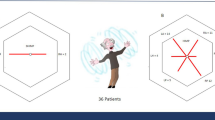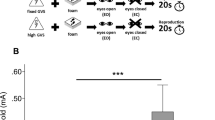Abstract
To identify vestibular dysfunction in children after cochlear implant surgery and to study the utility of static posturography in evaluating vestibular function in children. A prospective study was carried out on 25 children between 2 and 7 years of age with sensorineural hearing loss with no overt vestibular dysfunction. All children underwent static posturography using Synapsis Posturographic System (SPS) software (Version 3.0, REV C) using a static platform with foam. The centre of pressure (COP) shift was recorded as statokinesiogram on the software and the mean vestibular, visual and somesthetic scores were obtained. Cochlear implantation (CI) surgery was done with insertion of Med-El Pulsar standard cochlear implant with 12 twin electrodes. Children were evaluated again after 4 weeks of CI surgery (2 weeks after switch on) with static posturography on the same SPS software. The scores obtained were compared with pre op value and data analyzed statistically by paired t tests on SPSS 18 software. The mean age was 4.6 years with range 2–7 years. All the children in the study were able to complete the test with no difficulty and the mean time required for each child was 10.2 min. The mean pre op somesthetic score was 95.16 (SD 1.52) and post op score was 94.06 (SD 1.79). The mean pre op visual score was 86.64 (SD 2.24) and post op score was 82.55 (2.89). The mean pre op vestibular score was 84.11 (SD 2.20) and post op score was 73.66 (SD 4.25). Correlation and statistical analysis of the pre and post values of each score revealed statistically significant reduction in vestibular scores post CI. The vestibular system is at high risk of injury leading to vestibular dysfunction in children during CI. Our study found the static posturography as a simple, fast and efficient tool to screen children for vestibular dysfunction post CI. Identifying the dysfunction early can help in initiating early rehabilitation measures.






Similar content being viewed by others
References
Fina M, Skinner M, Goebel JA, Piccirillo JF, Neely JG, Black O (2003) Vestibular dysfunction after cochlear implantation. Otol Neurotol 24(2):234–242 (discussion 242)
Enticott JC, Tari S, Koh SM, Dowell RC, O’Leary SJ (2006) Cochlear implant and vestibular function. Otol Neurotol 27(6):824–830
Migliaccio AA, Della Santina CC, Carey JP, Niparko JK, Minor LB (2005) The vestibulo-ocular reflex response to head impulses rarely decreases after cochlear implantation. Otol Neurotol 26(4):655–660
Huygen PLM, Van den Broek P, Spies TH, Mens LHM, Admiraal RJC (1994) Does intra cochlear implantation jeopardise vestibular function? Ann otol Rhinol Laryngol 103:609–614
Black FO, Lilly DJ, Petrka RJ, Fowler LP, Simmons FB (1987) Vestibule ocular and vestibule spinal function before and after cochlear implant surgery. Ann Otol Rhinol Laryngol Suppl 128:106–109
Krause E, Louza JP, Hempel JM, Wechtenbruch J, Rader T, Gürkov R (2009) Effect of cochlear implantation on horizontal semicircular canal function. Eur Arch Otorhinolaryngol 266(6):811–817. doi:10.1007/s00405-008-0815-5 (Epub 2008 Sep 20)
Buchman CA, Joy J, Hodges A, Telischi FF, Balkany TJ (2004) Vestibular effects of cochlear implantation. Laryngoscope 114(10 Pt 2 Suppl 103):1–22
Todt I, Basta D, Ernst A (2008) Does the surgical approach in cochlear implantation influence the occurrence of postoperative vertigo? Otolaryngol Head Neck Surg 138(1):8–12
Filipo R, Patrizi M, La Gamma R, D’Elia C, La Rosa G, Barbara M (2006) Vestibular impairment and cochlear implantation. Acta Otolaryngol 126(12):1266–1274
Vibert D, Häusler R, Kompis M, Vischer M (2001) Vestibular function in patients with cochlear implantation. Acta Otolaryngol Suppl 545:29–34
Basta D, Todt I, Goepel F, Ernst A (2008) Loss of saccular function after cochlear implantation: the diagnostic impact of intracochlear electrically elicited vestibular evoked myogenic potentials. Audiol Neurootol 13(3):187–192
Oman CM, Young LR (1972) The physiological range of pressure difference and cupula deflections in the human semicircular canal. Acta Otolaryngol 74:324–331
Handzel O, Burgess BJ, Nadol JB Jr (2006) Histopathology of the peripheral vestibular system after cochlear implantation in the human. Otol Neurotol 27(1):57–64
Furman JMR, Baloh RW, Barin K et al (1993) Assessment: posturography. Report of the therapeutics and technology assessment subcommittee of the American Academy of Neurology. Neurology 43:1261–1264
Black FO, Wall C (1981) Comparison of vestibuloocular and vestibulospinal screening tests. Otolaryngol Head Neck Surg 89:811–817
Norre ME, Forrez G, Beckers A (1987) Vestibular habituation training and posturography in be- nign paroxysmal positioning vertigo. OH J Otorhinolaryngol Relat Spec 49:22–25
Wall C, Black FO (1983) Postural stability and rotational tests: their effectiveness for screening dizzy patients. Acta Otolaryngol (Stockh) 95:235–246
Di Fabio RP (1995) Sensitivity and specificity of platformposturography for identifying patients with vestibular dysfunction. Phys Ther 75:290–305
Wagner JH, Basta D, Wagner F, Seidl RO, Ernst A, Todt I (2010) Vestibular and taste disorders after bilateral cochlear implantation. Eur Arch Otorhinolaryngol 267(12):1849–1854
Author information
Authors and Affiliations
Corresponding author
Ethics declarations
Conflict of interest
No author has received any research grants and have any conflict of interests.
Ethical Approval
All procedures performed in studies involving human participants were in accordance with the ethical standards of the institutional and/or national research committee and with the 1964 Helsinki declaration and its later amendments or comparable ethical standards.
Informed Consent
Informed consent was obtained from all individual participants/parents or guardians included in the study.
Rights and permissions
About this article
Cite this article
Nair, S., Gupta, A., Nilakantan, A. et al. Impaired Vestibular Function After Cochlear Implantation in Children: Role of Static Posturography. Indian J Otolaryngol Head Neck Surg 69, 252–258 (2017). https://doi.org/10.1007/s12070-017-1124-3
Received:
Accepted:
Published:
Issue Date:
DOI: https://doi.org/10.1007/s12070-017-1124-3




